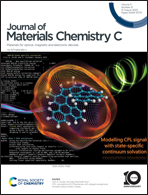Achieving excellent thermostable red emission in singly Mn2+-doped near-zero thermal expansion (NZTE) material Li2Zn3(P2O7)2†
Abstract
The design of thermostable phosphor is still a pivotal challenge in pc-WLED applications. Herein, an efficient strategy is proposed to design excellent thermostable red emission in the singly Mn2+-doped near-zero thermal expansion (NZTE) material Li2Zn3(P2O7)2. Under the excitation of 412 nm wavelength, the emission could be tuned from 636 to 672 nm by increasing the Mn2+-doping level via synthetic effects among the crystal field, the exchange coupling interaction in Mn–Mn dimers, and energy transfer in different luminescence centers. The PL intensity of LZPO:Mn2+ could be maintained at 97% at 150 °C and 94% at 200 °C of its initial intensity at room temperature. During the heating process, LZPO presented near-zero thermal expansion, contributing to the nearly unaffected PL intensity. The emission loss was also compensated by trap-assisted energy transfer to the luminescent center. This study not only offers a perspective idea for elucidating the correlation between the crystal structure and optical properties, but also opens a new way of designing excellent thermostable luminescent materials based on NZTE materials in self-reduction systems.



 Please wait while we load your content...
Please wait while we load your content...